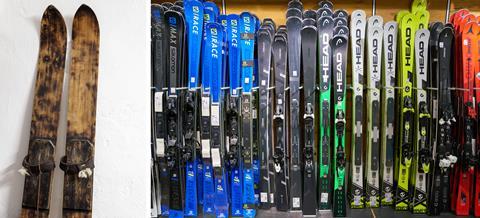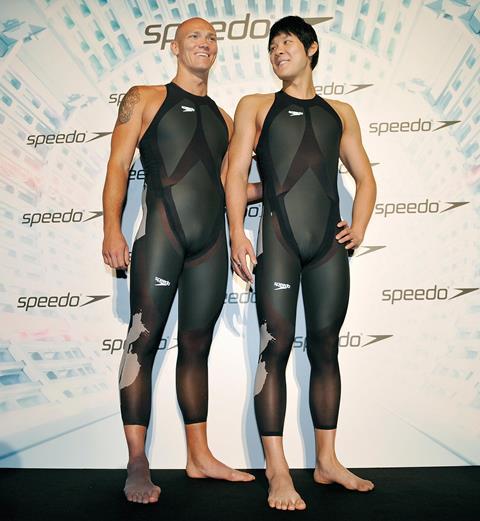While elite sports have been improved by materials science, for disabled athletes the developments can be life-changing. Aisha Al-Janabi reports
With the 2022 winter Olympic games about to begin on 4 February in Beijing, China, followed by the winter Paralympic games on 4 March, the eyes of a sport-obsessed world will be on the athletes and their performances. But look more closely and you’ll see some high-performing materials helping the athletes achieve their dreams.
Sports equipment was once made of natural materials such as wood, twine, leather and ox guts, but thanks to chemistry, most is now made of various combinations of materials which are specific to each sport.
‘These new materials also enhance the performance of those playing sports,’ says Andy Parsons, an organic chemistry lecturer at the University of York, UK, who also runs an online course about the everyday applications of chemistry, including materials in sports.
‘Chemists have developed new, cheaper synthetic materials like polymers or plastics which allow most people to play sports,’ says Parsons, especially as natural materials can be expensive or only available in limited supply. As you might expect, many different types of polymers are used in sports equipment (see box Polymers rule, OK below), with winter sports no exception.
The many layers of skis
High density polyethylene has a high strength-to-density ratio making it strong and lightweight, suitable for skis and snowboards. Kam Leang is a professor of mechanical engineering at the University of Utah in the US – and an avid skier. Leang learnt to make his own skis from his cousin and has continued to do so for a number of years. Leang explains that making a pair of functional skis is relatively simple, especially as traditional skis were made using just wood that was steamed into shape. Modern skis, however, are a bit more complicated and consist of different layers and materials to optimise their properties and performance.

There are three layers to a ski: the base, the core and an epoxy resin, all of which is encased with a metal alloy along the edges. The base of a ski is made of high-density polythene, a plastic that slides well and maintains its properties at low temperatures. On top of this is the core, often made of a combination of polymer foams, woods or metal alloys. Leang, however, has made skis from more unusual materials: ‘I thought it was cool from a sustainability aspect, so I’ve worked on skis where I try to use recycled materials. Recycled wood, for example, works great. Cardboard, not so much.’ As Leang expected, the cardboard absorbed too much resin making the skis very heavy, although they were still functional – sort of. The epoxy resin contains materials with a high modulus like carbon fibre or fibreglass to support the structural load of the ski. This is needed because, as Leang explains, ‘wood itself will break if you use it as a ski and flex it too much … so, in order to carry the load, you need to combine it with another material’.
Leang explains there are four factors to consider when designing skis: shape, flexibility, mass and damping. Damping is the ability of the skis to absorb vibrations, which is the hardest to control. The faster you ski, the more the skis vibrate, which causes them to lose contact with the surface making them harder to control. This is especially a problem for Olympic skiers who speed down the slopes at close to 100 miles per hour.
‘In order to have damping, you have to essentially determine how [the skis] flex and where certain materials that have better damping characteristics need to be placed.’ Leang has experimented with improving this property in the lab using functionalised carbon nanotubes suspended in the epoxy resin. The nanocomposites are functionalised so they slide over each other when the skis vibrate, like the pages of a book when you bend it. This relative motion between the nanotubes causes friction, resulting in heat that dissipates and cannot be recovered, introducing damping. ‘The cool thing is that by doing that you don’t change the mass of the ski [by much] … it’s like 0.5–1% volume fraction, it’s very little.’ However, the cost of this means it will remain in the lab and away from snowy slopes for now.
Polymers rule, OK?
Many polymers are used in sports equipment as they ‘can provide enhanced comfort, convenience, better consistency and functionality over traditional materials’, explains Andy Parson of the University of York. For example, polycarbonates are not brittle and can be moulded easily into different and unusual shapes making this a suitable choice for canoes, kayaks and safety equipment like helmets. Parsons adds that polycarbonates also have ‘high-impact resistance, are shatterproof [and] transparent, which explains their use in goggles, visors and facemasks’.

‘In contrast, we’ve got polyurethane called spandex which is a popular material for sports clothing,’ says Parsons. Developed in the 1950s, spandex is the name of the synthetic fibre also known as elastane, a polyether–polyurea copolymer, and used by DuPont to make garments with the trade name Lycra. ‘Spandex is lightweight, but it doesn’t get damaged by sunlight, sweat or detergents, all of which can damage other traditional materials such as wool,’ Parsons explains, making it an ideal material and used in clothing for many different sports.
Polyurethane is also found in the core of tennis racket handles and wrapped in carbon fibre reinforced polyamide layers, which imparts a higher force on a ball than traditional materials like wood. Parsons explains that ‘the ultimate design of sports equipment is to enhance performance as well as make the equipment as user-friendly as possible and help the athlete avoid injury’. This tennis racket handle design does just that, as it also dampens the vibrations experienced by wrists and elbows, therefore reducing risk of injury.
Nanomaterials are another popular choice and found across many different sports. These are materials with at least one dimension confined to the nanometre scale, such as carbon fibre. ‘[Carbon fibre] gives an increased strength to weight ratio and it provides tougher impact properties than can be achieved using other composite materials,’ says Parsons. For example, carbon fibre bikes are now the standard choice for competitive cyclists because they are lighter, stronger and more durable. Additionally, ‘the vibration dampening qualities of carbon fibre helps to ensure a really smooth ride’. While the performance properties of nanomaterials are impressive, Parsons cautions that carbon fibre is not easy to repair which can limit the lifespan of the kit, and therefore is not always the best option for all cyclists.
‘The materials of choice are often composites,’ Parsons explains, made of two or more materials with different chemical and physical properties that are combined to produce a material with its own unique characteristics. ‘We’re often aiming for a material that has the highest possible stiffness for the least possible weight,’ says Parsons. ‘We’re looking at low density materials with the highest specific modulus and that means the highest stiffness to weight ratio.’
Technological doping
While scientific advances are often embraced in competitive sports like the Olympics, not all end up being permitted by the authorities who govern the sports. This can be because the improvements go too far and are considered an unfair advantage to athletes, ultimately leading to their ban in competitions. ‘The World Anti-Doping Agency not only has responsibility for tackling drugs, but its remit also covers sports equipment,’ says Parsons.
In 2021, for example, the international governing body of skiing and snowboarding, the FIS, banned fluorine-containing ski wax ‘not because of improved performance but because of environmental and health concerns’, explains Parsons. Ski wax is used in downhill skiing to help the skis glide over the snow and repel water, which makes fluorine an ideal component.
Merle Plassmann is a lab manager at the Institute for Environmental Science at the Stockholm University, and studied ski wax on the slopes of Vasaloppet in Sweden for her PhD. ‘The idea was to analyse one of the main fluorinated ingredients, the semifluorinated n-alkanes,’ says Plassmann. ‘I established a method for analysis using GC-MS and then went out to the ski tracks to see if we could find them there.’ Fluorine-containing compounds either do not break down naturally, or they break down into other persistent substances meaning they accumulate on the slopes, which led to this new ruling. Additionally, ‘some of these substances have been shown to have toxic effects on both animals and humans’. The ban on fluorine-containing ski wax might not be the last of this kind, according to Parsons. ‘I anticipate that there will be a greater emphasis on sustainability in sports material.’
Other technologies have been banned because ‘there is a feeling that it could make certain sports easier, could create unfairness and ensure that rich athletes have an advantage’, says Parsons, an advantage sometimes referred to as technology doping.

In snowsports, the authorities banned a skisuit that was claimed to reduce drag by up to 40% in 1994. In a more famous case, the LZR swimsuit, made by Speedo and co-developed with Nasa, was considered to be technology doping and was banned by Fina, the International Swimming Federation, in 2009. This is a full-body swimsuit made using polyurethane and nylon polymers which streamlines the swimmer through high compression of the body. ‘It’s designed to mimic shark skin and it’s reported to reduce skin friction drag in the water by an incredible 24%,’ says Parsons. Of the 25 world records broken in the 2008 Olympic games, 23 competitors were wearing the LZR swimsuit. The last time so many world records were broken at once was when swimming goggles were introduced in the 1976 Olympic games, but goggles come at a fraction of the cost of this shark-like swimsuit. The new ruling states that swimsuits must be made of textiles that are woven together, which prevents plastics being used.
The cost is just ludicrous: you could buy a car for the cost of a wheelchair
But care must be taken to ensure banning technology does not result in an even more uneven playing field. Ian Brittain is a Paralympic historian who is interested in the social impact of the Paralympic games. Brittain explains that the term ‘technology doping’ can be used to prevent disabled athletes competing against non-disabled athletes by claiming they are at an advantage because of ‘technical aids’. In 2007 World Athletics, the international athletics governing body, declared that no technical aids could be used by athletes in the Olympics. ‘They can’t win either way,’ says Brittain: disabled athletes are being prevented from competing because of the very technology that allows them to compete in the first place.
Equipment in disabled sports has massively changed over the decades, as Brittain describes. ‘In the 1950s and 60s, there was only one kind of wheelchair and it was a big clunking thing with a big leather bound back to it,’ which was used for all sports. Now, there are specifically designed wheelchairs for many sports, such as carbon fibre racing chairs made by BMW for the US athletics team. ‘The cost is just ludicrous: you could buy a car for the cost of a [daily use] wheelchair,’ warns Brittain, adding that the cost of living for a disabled person can be 60% higher than a non-disabled person.
Brittain gave the example of a double leg amputee to highlight regulations specific to the Paralympic games. ‘If you have two prosthetics, those prosthetics are not allowed to make them taller than if they had their legs.’ This means an athlete’s stride length cannot be increased by their prosthetics and ‘has to be in keeping with what their natural body size would have been.’
The first Summer Paralympic games that included impairments other than spinal cord injuries took place in 1976 in Toronto, Canada, when 1657 athletes from 40 countries competed. This was also the same year where the first ever Winter Paralympic games occurred in Örnsköldsvik, Sweden, which only had two sports: alpine and cross-country skiing. Since then, this has increased to include seven disciplines: alpine and cross-country skiing, biathlon, curling, para-ice hockey and snowboarding.
Technical repair
All this technology will experience wear and tear over the course of a Paralympics event, and Ottobock, a prosthetics company, has been partnering with the Paralympic games since 1988 to provide repairs. Peter Franzel, head of global events at Ottobock, explains the necessity of the Technical Repair Service: ‘You can be the world’s best skier, but if your wheelchair is broken and you cannot leave your accommodation, you will not be able to go to your competition area,’ adding that the majority of repairs are on daily equipment like wheelchairs. Anyone, from athletes to coaches and family members, can visit the facility for a repair regardless of the brand and at no cost.
In the 2020 Tokyo Paralympic Games, 2038 repairs were carried out by the 106 engineers from Ottobock. To equip the repair centre, four 40-foot containers filled with different tools and machinery along with 19,000 spare parts were shipped to Tokyo, highlighting just how key materials and engineering is to sports.
‘You never know what’s the next job for you, because sometimes the tyre is flat of a wheelchair, then that’s easy,’ says Franzel, or sometimes a sit ski frame is cracked or broken and needs attention. Sit skis consist of an Alpine ski with a mechanical unit attached, using the suspension mechanism from motorcycles. ‘The athlete is tied to this sit ski, which is sometimes made of plastic or carbon fibre, and depending on this we need to have the right equipment to repair the damage,’ explains Franzel.
Carbon fibre is also used in racing prosthetics, which were first used in the 1988 Paralympic Games in Seoul, and have remained a popular choice of material ever since.
Surprising simplicity
‘Prosthetics used in sports are technically very simple,’ explains Franzel. In comparison, daily prosthetics can have microprocessor controlled knees that recognise if someone is sitting down or falling and respond accordingly, and are designed to work when walking backwards. Knee joints in racing prosthetics, however, ‘only need to go very fast forward and they have no security related systems inside, they have no prevention of falling’, explains Franzel.

The characteristics of the racing prosthetic are determined by how the carbon fibre layers are combined and their orientation, according to Franzel. Carbon fibre is often combined with a synthetic polymer, as Parsons explains ‘these provide just the right balance of stiffness and flex at a substantially reduced weight compared to conventional materials such as wood’.
Another factor is the thickness and the overall shape of the prosthetic which changes how soft or hard the blade is, something that needs to be tailored to the athlete’s bodyweight. Franzel explains that a heavier person produces more power and force so a thicker material with more layers is needed, to make a prosthetic that can withstand this. ‘All the force that is in those blades, if there is a crack in the carbon fibre it’s done for,’ explains Franzel. ‘You cannot repair it, and you need to replace them.’
Carbon fibre is sometimes also used to create the socket of the prosthetic, but ‘most of the time it’s made with thermoplastics’. says Franzel. ‘This is a plastic that when you heat it you can shape it, which is important because this socket needs to 100% fit the stump.’ Recently, advances in 3D printing technology have meant these materials are increasingly being used to make the socket in both racing and daily use prosthetics.
Franzel recommends watching para-ice hockey or visually impaired alpine skiing in the Paralympic Games. ‘If you are a skier, you know how it feels to go down a slope, and visually impaired skiers have a guy driving before them just shouting “right, left, stop, slow, fast”!’ Whilst watching, take a moment to appreciate the many complex layers in the ski and how its properties have been tweaked over the decades along with scientific advancements.
Athletic performance, safety, comfort and more recently sustainability all need to be considered when designing equipment for different sports and will continue to be fine-tuned. ‘In elite sports, really small margins will define a winning performance’, says Parsons. ‘So these materials can have a massive impact and they have revolutionised some sports.’
Aisha Al-Janabi is a science writer based in London, UK













No comments yet